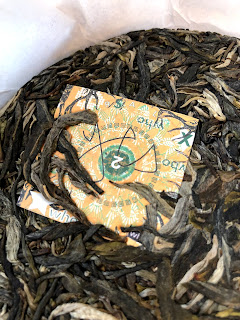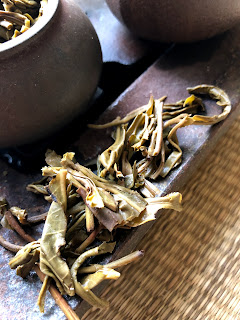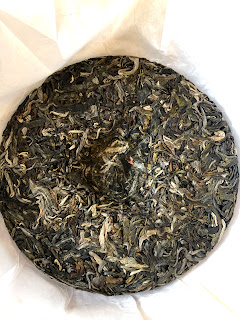There are two kinds of
people in the world
One who has a more
difficult time giving a gift
And one who has a more
difficult time receiving one.
-Unknown
I think it’s safe to say that I am the later and Paul of
white2tea is the former… And so here we are in this current predicament… There
is a bit of history to the name of this puerh cake “Is A Gift”...
Its origin can be partly traced all the way back to a reddit thread and a review of 2015 white2tea Little Walk by commenter tinkle4 who
called the cake a real snoozefest.
This meaning is one of the generally accepted origins of the famous
limited 2017 & 2018 Black Friday sheng puerh offerings at white2tea,
the Snoozefest. By
naming these cakes “Snoozefest” , Paul has essentially responded to a critic with the response of a
pink coloured cake along with finishing the cake description with “All Love ;-)
“
On this blog I put this cake under the microscope over the
past few years, in part as an analogy that represented the white2tea brand (and
in part a critique of the puerh industry as a whole even consumerism as a whole). The first article I published about the 2017
Snoozefest cake was a very critical article about the philosophical
underpinnings of Paul and white2tea. In
fact, I have published a few fair but pretty critical articles about white2tea (here
and here). Conversely, I also try to
show Paul and white2tea lots of, well deserved, love as well (here). When the cake was released again in 2018, I
published a second article about the 2018 Snoozefest which was apologetic about
my overly critical position, it struck a tone of positivity. The final conclusion that I reached about
these Snoozefest is as follows:
I realize that
“Snoozefest” has a different meaning all together. Offering a puerh cake at $0.08/g of fresh
puerh has to be pushing that lower profit limit for most of our western puerh
vendors like white2tea… So, I now feel
that offering fresh puerh at $0.08/g is probably a gift in and of itself. Something, I failed to understand a year ago.
The wider meaning of “Is A Gift” is sharing, giving,
positivity, love, forgiveness, apology, all inspiring themes that are repeated
over and over in the 2019 white2tea spring sheng puerh line up. The wrapper then states “Be Nice” with a
heart dotting the “I”. In the same way Snoozefest is a response to tinkle4 and
his critique of 2015 Little Walk, the name, wrapper design, and description of
2019 white2tea Is A Gift is a response to my critique and later realization
that Snoozefest is a gift.

In the email that launched the 2019 white2tea Spring sheng
puerh line up there was quick list of recommendations with links that best
describe you. The link to 2019 white2tea
Is A Gift was “I’m a millionaire who enjoys a good fight.” This description was the most unusual of all
the descriptions, I think. However, it
spoke to the fact that this cake was designed for the critics “who enjoy a good fight.” Conversely, it also criticizes the critics. It points out that those who often seem to be
the most critical (tinkle4 and MattCha) are also criticizing the absolute
cheapest, or bottom of the white2tea brand.
In a way, calling us a millionaire is calling us out.
Alternatively, the name “Is A Gift” is kind of fitting for
this cake because the description of the cake seems to make it an immediate
target for its critics (i.e. the description is such that it makes this puerh a
gift to those who criticize the white2tea philosophical brand). The description
is as follows:
2019 is a gift is a
small production of difficult to acquire material that rarely sees the light of
day in the larger market.
Basically, this description seems like Paul is saying that
this is gushu (ancient arbour puerh) without actually stating it outright. What else is small production, difficult to
acquire, that rarely gets offered??? I
guess it could be Gouyoulin (protected state park material)? Or from a famous producing
area? Or from a Secret Garden in a remote location? This comment is playing with the marketing
ploy of presenting rarity, scarcity, and limited access. For someone who doesn’t like to use the word
Gushu to describe sheng puerh, it sounds like he pretty much said everything he
could without actually saying it. In the
end, the description has the same marketing effect of outright stating “gushu”
without actually saying it… just say it… its OK…
A few other interpretations of the wrapper design… The use of blurry imaging that represents a
common critique of white2tea’s use of blurry messaging as a marketing strategy. Many other cakes in the 2019 line up also
have this feature. Also, the use of red
(Republicans) and Blue (Democrats) could also have a subtle political innuendo
“Be Nice” which speaks to the current combatant political climate and can be interpreted in a similar way as “We Go High”.
The description of 2019 Is A Gift ends with this:
A strong and engaging
tea for special occasions.
Anyways, the question about this puerh has to be framed like
this…
Is 2019 white2tea Is A Gift truly a special and rare tea
gift that is maybe priced well under Paul’s normal mark up like the Snoozefest
cakes only more premium (many Western vendors end up reducing the mark up on
the most expensive productions) ? Or
maybe it offers us an experience that no other puerh could offer?
Or
Is 2019 white2tea Is A Gift essentially a gift to critics
because you are basically paying large sums of money for apparent scarcity and
limited access but that which the quality of the tea and the tea experience
cannot justify or support?
There is only one way to find out…
The dry leaves smell of intensely piercingly fresh fruity
candy cherry sweetness, intense pungent almost black pepper, rainforest, and
underlying very faint woodiness.
The wet leaves look and smell ultra fresh green and melon
fruit and I’m left immediately thinking this is a boarder tea.
The first infusion has a warm spicy pungent start which
converts to soft sugar pungency and long evolving sweetness. The aftertaste is slightly mellon. The mouthfeel and tongue carry a nice
stickiness to them which carry melon fruit tastes into the distance. The Qi starts to feel relaxing in the head.
The second has a more yeasty, bready warm spices pungent
onset which has a very mild bitterness underneath and pushes out tastes of
honeydew melon and, to a lesser extent sweet bread in the aftertaste. The taste is really smooth and pretty gentle. The mouthfeeling and throatfeel are moderately
sticky. The tongue is the most obviously
stimulated by the stickiness. The Qi is
already having a mild spacy feeling.
The third infusion has a spicy, almost bready and moderately
bitter onset. The mouthfeel is pretty
thick and sticky almost sandy-sticky especially on the tongue. The throatfeel is medium deep and is
stimulating enough to push saliva into the mouth. This infusion the bitterness strengthens and
becomes moderate-strong but the initial flavours disappear under the bitter and
are not powerful. Mainly a faint
honeydew melon trailing in the aftertaste.
The Qi is pretty strong though, very spacy almost stoner feeling in
head. My head feels like its floating
away from neck.
The fourth infusion has a strong burst of initial flavor- of
bitter and sweet mellon which splash up into the mouth. The taste is really clean and pure with not
much depth. The pungent coolness and
returning sweetness are very very mild and the taste is mainly just an
extension of these intial simple polarities of moderate bitter and sweet
honeydew melon and faint sweet bread.
There are soft glimpses of rainforest in there as well. The Qi is building in the head and spacing me
out nicely.
The fifth infusion start very bitter with mellon and now a
floral note with honeydew and sweet bread.
The taste is very simple. The
bitterness is become quite intense. The
mouthfeeling starts to pucker up a bit and is really stimulating but it fails
to push much interesting flavor out. The
aftertaste is bitter, and a melon sweetness.
Qi in head is very distinct and obvious.
This cake is about the Qi.
The sixth infusion starts off with an intense bitter and
bread and honeydew mellon taste. The
mouthfeeling is very pucker and the throat is medium deep and quite stimulating
from the barrage of bitter tastes. The
taste profile is very clear, pure, simple, unadulterated- this is single origin
arbor material. Qi is really big and
strong. It clouds the mind in stupor,
head heavy and floating. Feeling
unproductive and can’t find words. This
tea is all about the Qi. The wet leaves
smell floral. There is just a ghostly
amount of this in the after taste. This
tea is very green processed.
The seventh infusion has a coco chocolate bitterness,
licorice root sweetness, slight warm spiciness, bready sweetness initially with
more of the melon and floral green taste coming out in the aftertaste. The aftertaste is not deep or that long. The bitterness is quicker moving here in this
infusion. The mouthfeel is sticky and
sandy on tongue. Head floats away and I
am left in a stupor.
The eighth infusion starts almost floral sweet bread and
melon with bitter. There is almost non-existent
cooling pungent which eases into melon sweetness in the aftertaste.
The ninth infusion starts with burnt rubber/coco bitterness
which really dominates. The mouthfeeling
is pucker. The throat is open and
stimulated. The bitter overwhelms the
barely bread and melon tastes. The head
floats. The bitterness is a bit rough on
the digestion which signals to me that this tea should be aged not consumed
fresh. In the body I can feel my heart
beating but not racing, like its slowing.
Qi is really pronounced.
The tenth infusion starts off with a bready sweetness which
changes to bitter fast. The coco and
rubbery bitterness lingers into the aftertaste where melon fruit appears as
well as soft floral. The taste is real
simple and pure and green and bitter.
Spacy Spacy stoner Qi. Pretty
intense mouth pucker bitterness.
The eleventh infusion starts off melon more than bread
sweetness with distinct bitter this clear profile stumbles into the aftertaste
with just a melon floral finish. Big Qi
continues its onslaught on my soul.
The 12th infusion starts off almost a mild
buttery sweet bread with a strong coco/ rubber bitterness very shortly
behind. The bread tastes recede and
bitter with melon and faint floral is left on the breath. The bitter taste is dominant and obvious were
the other tastes are pretty mild and simple.
This is the most simple tasting puerh I’ve had from white2tea which
suggests it is probably single origin.
The 13th infusion has a more floral onset with
melon and bitterness coming shortly behind then stretching into the
aftertaste. The floral stays in the
infusion throughout. Mild tastes, mainly
bitter. Mouthfeeling and tongue dry,
pucker with throat moderately deep.
The 14th starts floral- melon sweetness the bread
sweetness is gone the last few infusions.
Long coco bitter with melon and floral.
Not that sweet really, mainly just bitter. Big Qi in the head, spacey, feel it in heart.
The 15th infusion has more of a buttery floral
orchid initial onset with bitter that is still obvious but less intense. The bitter and floral taste lingers but I
wouldn’t say it’s a particularly long aftertaste. Qi.
The sixteenth has an almost green tea approach with vegital
bitterness and floral sensibility with honeydew melon nuance. The bitterness is less here. The flavor movement from initial to aftertaste
is simple and uncomplicated, the tastes are pure and clean, shortish
aftertaste. A sweet mild melon nuance is
most apparent in this infusion there is a floral trailing off.
The seventeenth infusion is juicy sweet melon which slides
into a mild pop of sweetness then very mild bitter and melon nuance. Very muted floral arrives 30 seconds later.
The eighteenth starts juicy melon again very mild bitter
more melon. Not to exciting. Mouthfeel
is mainly sandy without the bitter nuance the mouthfeel is more sandy than
sticky or pucker. The mouthfeel
throughout is pretty moderate/even week but is more stimulated by the burst of
bitterness.
The ninteeth starts a dry woody bark bitter and barely
melon. It eases into a floral
nuance. The Qi changes here and is felt
more in the should and arms feeling wobbly and light, more of a floating arms
and head feeling. Qi is more sedating
now.
The 20th starts off almost rubbery bitter woody
bark melon. The mouthfeeling is a sandy
almost dry stickiness. The qi in the
mind is restless and sedating at the same time.
Some times there is the faintest barely coolness on the inhale.
The 21st infusion is a mild sweet melon with dry
woody bark bitter the melon sweet mildly crests then floral… this is getting
pretty unexciting but the Qi eggs me on…
I add a ten seconds to the flash infusion to see what
happens in the 22nd infusion its spent basically sweet melon water
now. It will rest in an overnight
infusion.
So now, this much is clear…
2019 white2tea Is A Gift offers us the gift of an
interesting and powerful Qi experience
The gift is the Qi! I have not yet tried a white2tea puerh
that offers a more profound Qi sensation although I have not ever sampled the
top of the brand before nor can I even compare it to the 2019 Lucky Puppy of
relatively same price and producing season.
Readers know that I define the quality of a tea almost solely on the Qi
sensation, therefore I feel that this is an appropriate gift for me… thank you
kindly Paul.
Truly, the taste is not very exciting and offers a narrow
range of mild tastes that change very little throughout the session. If you are looking to purchase for the
flavours alone, don’t bother with this one.
The basic tastes consist of sweet melon, faint floral orchid, in the
later infusions dry wood bark. It’s
quite heavy on coco/rubber bitterness.
This bitterness is moderate-high and fades only late into the
session. The monotone and predicable
nature of the taste suggest that this might be a rare single origin production
from white2tea. Strong bitter coco/rubber
with a distinct melon sweetness and very little pungent cooling… that pretty
much exactly describes the LaomanE character exactly in my experience.
The “powerful” in the vendor description is both its
bitterness and Qi Sensation. The
“engaging” is definitely not the taste, but rather the bitterness and Qi sensation
as well, maybe even the stronger mouthfeeling.

Let’s look at the leaves for some clues… The leaves are very
tippy and small picked almost uniformly 2 leaves and a bud (the astonishing
uniformity again suggests single origin and also suggests very early spring
flush). Maybe the quality/ date of the
picking is part of the rarity in the vendor description? Maybe it is a small leaf variety in an
uncommon location outside off the typical Yibang and Jingmai (of which this
teas taste does not resemble). Or
conversely, maybe it is an unusually bitter, unconventional, and powerful
single origin find from one of these regions.
Typically, a small leaf variety is not this intensely bitter and usually
much more sweet. What is common with the
smaller leaf variety is the intense Qi sensation which this tea has a lot
of. It’s a reason I am found of Yibang despite
me not always being in love with its taste.
The value…. That’s another thing. Is this crazy expensive tea worth it? At $1.25/g you can surely find better Qi for cheaper…
probably but the summation of qualities that this tea has with the very intense
bitter with small leaves varietal, all 2 leaves and a bud… not sure. I think for those of you who drink for the Qi
and not for the taste, this is your gift and at least a sample is in order
here.
Thanks for pressing this one Paul… Yes, I graciously accept.
Peace
Edit June 14, 2019: I tried this one a week later using 1/3 less leaf as I usually do and I got a really different session. The bitterness stayed in the rage closer to moderate than high. The flavors didn't really resemble LaomanE at all but were more buttery and floral and almost no honeydew Mellon or coco/rubbery bitterness. It was more mineral, floral, and slight buttery. The tastes were much less exciting than a fully stuffed pot and didn't change much throughout the session. Upper throat has a tight sensation that I notice more today. Qi was again nice and powerful. This is a Qi puerh for sure. How do these tinny little leaves have so much power? Many thanks to Paul for pressing this. I'm going to wrap this one up soon and try it in a few months.
Double Peace












